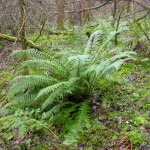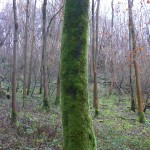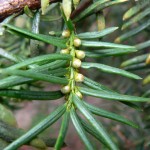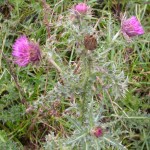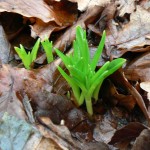The first mid-week walk of 2014 was on the mild, damp morning of Wednesday 15 January, when Jan Haseler led a walk which started from the National Trust car park at the top of Streatley Hill. The Hazels beside the car park were already covered with catkins. The walk started out across the road to The Holies and continued along the track at the top of the woods, before turning left down the steep path towards the village. Most of the trees had a skirt of moss around their bases, but a Beech tree to the left of the path had moss growing to a height of at least 5 metres. The moss was identified as predominantly Kindbergia praelonga by Sue White. In the woods on the other side of the path were several particularly big and prominent clumps of ferns. Closer inspection of the undersides of the fronds revealed black dots at the bases of the pinnae, diagnostic of Scaly Male-fern. Nearby were less conspicuous clumps of Male-fern which were beginning to die back for the winter. The route then turned right along a footpath which contoured through the woods. The talk at the Society’s previous evening meeting had been about using pollen to solve crime and a pollen calendar had been displayed, with Yew being the first species in the year to shed pollen. A number of Yews next to the path were inspected for flowers and pollen. We had learned that there were separate male and female trees. The trees all appeared to be males, with creamy still-closed flower buds, which worried us about our identification skills. Reassuringly, a number of female trees, with traces of the previous season’s berries, were found later in the walk. Initially, the Beech trees were all tall and single-stemmed, but further on there were some many-stemmed specimens which probably started life in pastureland, rather than woodland. A Herb-Robert plant, growing out of the moss on top of a dead tree stump, was in flower.
A Song Thrush was singing as the group emerged from the woods. The route then followed a willow hedge across a field at the top of the site before dropping down onto fine chalk grassland. Seed-heads of Marjoram, Carline Thistle and Wild Carrot were identified and gentian and orchid flower-heads were also found. Amongst the grass were patches of Homalothecium lutescens, a greenish-gold moss which is characteristic of short unimproved calcarious grassland. There were distant views of the flooded fields beside the Thames and a Buzzard glided above the trees. After dropping down almost to the road, the walk continued up the steep track towards High Holies. Amongst the Beech trees beside the track were a few Whitebeams, with much darker trunks. New spikes of Lords-and-Ladies were beginning to emerge. Continuing down the other side of the ridge, a clump of Stinking Hellebore in full flower was found in the verge at the side of the lane. The route then led through a small copse, where a Great Spotted Woodpecker and a Bullfinch were heard and a twig with pink Coral-spot fungus was found. The next footpath led back steeply up the hill towards The Holies. Between the footpath and the field edge was an unploughed section which had abundant flowering Musk Thistles, with a scattering of Bristly Oxtongue plants, some of which were in flower. After negotiating a rather awkward stile back onto the National Trust land, the group turned left and followed the footpath which ran above the edge of the field. Primrose plants beside the path had rosettes of new leaves. A number of trees in the wood at the end of the path had blown down in the recent gales. Bluebell leaves poking up out of the leaf litter were at a surprisingly advanced stage for mid-January. Snowdrops were in flower at the side of the track back to the car park. The walk was followed by lunch at The Four Points near Aldworth.
Pictures by Laurie and Jan Haseler

